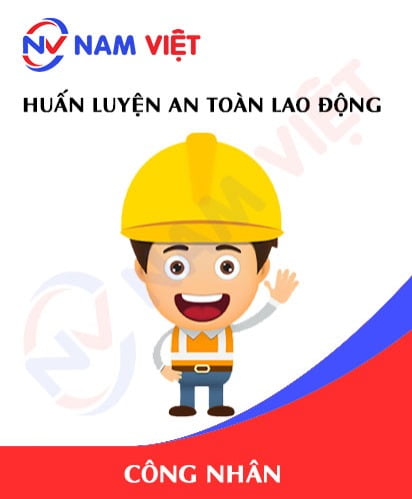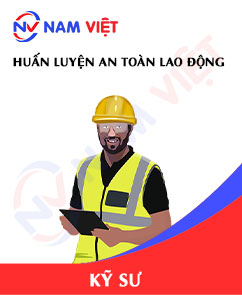Occupational Safety Training for Workers
99,000 ₫
Note: The above price is calculated for one person, the price may fluctuate depending on the number of trainees attending the course and market movements. For more accurate pricing support, please refer to the price list or contact our consulting staff directly.
The Occupational Safety Training for Workers course is a training program providing Group 3 occupational safety knowledge. The course will raise awareness of how to prevent workplace accidents during production operations for trainees. Accordingly, the occupational safety training content follows closely Article 18 Decree 44/2016/ND-CP.
Table of Contents
Toggle1. Overview of Workers
a. The important role of workers
- A worker is a professional laborer, often hired to work in a factory, workshop, farm, or construction site. Workers can perform many different types of jobs, including production, processing, assembly, quality control, maintenance, repair, and operating production equipment and machinery.
- Workers are typically manual or direct laborers who directly create products, wealth, and material goods to fulfill assigned tasks in fields such as manufacturing, mechanical engineering, electronics, construction, and many others. Many worker jobs require a high degree of concentration and precision during execution.
- Workers play a significant role in the economy, contributing to the production and development of businesses and the country. However, the work of a worker can involve many risks to labor safety; therefore, businesses need to pay attention to labor protection measures and ensure worker safety.

b. Workers in various fields and professions
Workers are laborers in the manufacturing, construction, fabrication, agriculture, handicrafts, and service industries. As a result, most professions and fields have workers, including:
- Manufacturing industry: machinery manufacturing, consumer goods production, metal production, electronics, and high-tech manufacturing.
- Construction industry: building houses, bridges, roads, buildings, irrigation works, railways, roads, waterways, and marine structures.
- Agriculture industry: cultivation, animal husbandry, and forestry exploitation.
- Handicrafts industry: producing ceramics, handicrafts, jewelry, and footwear.
- Service industry: hotel services, restaurants, healthcare, environmental sanitation, pet care, and many other professions.
2. Overview of the safety training course for workers
a. What is labor safety training for workers?
- The labor safety training for workers is a training program to equip workers with labor safety skills at construction sites, factories, and production facilities. The program aims to help workers understand the potential dangers that can occur during work and how to prevent and handle incidents.
- Accordingly, workers who directly work in strict conditions with hazardous factors belong to Group 3, while the others belong to Group 4.
- The labor safety training course will help employees recognize and avoid dangers, limiting the risks of occupational accidents during work.
REGISTER FOR LABOR SAFETY TRAINING SERVICE
b. Training duration
Initial safety training duration for Group 3
- The total training duration is at least 24 hours, including the examination time.
- 8 hours of theoretical study on the system of policies and laws on occupational safety and hygiene
- 8 hours of theoretical study on basic knowledge of occupational safety and hygiene
- 4 hours of theoretical study on specialized training content
- 2 hours of practical training on specialized training content
- 2 hours for the theoretical exam at the end of the training course
Initial safety training duration for Group 4
- The total training duration is at least 16 hours, including the examination time.
- 8 hours of theoretical study on basic knowledge of occupational safety and hygiene
- 6 hours of practical training on direct training content at the workplace
- 2 hours for the theoretical exam at the end of the training course
Periodic safety training duration
- Before the labor safety card expires, if employees want to have it reissued, they must undergo a periodic labor safety training course, with the periodic safety training duration being at least 50% of the initial safety training duration.
c. Content of the training course
Group 3 training content
| No. | TRAINING CONTENT | Training duration (hours) | |||
| Total | Of which | ||||
| Theory | Practice | Test | |||
| I | System of policies and laws on occupational safety and hygiene | 8 | 8 | 0 | 0 |
| 1 | Overview of the system of legal normative documents on occupational safety and hygiene. | 6 | 6 | ||
| 2 | System of technical standards and regulations on occupational safety and hygiene. | 1 | 1 | ||
| 3 | Specific regulations of state management agencies on occupational safety and hygiene when building new, expanding, or renovating works, facilities for manufacturing, using, preserving, storing, and inspecting machinery, equipment, materials, and substances with strict requirements for occupational safety and hygiene. | 1 | 1 | ||
| II | Basic knowledge of occupational safety and hygiene | 8 | 8 | ||
| 1 | Basic knowledge of dangerous and harmful factors at the workplace. | 4 | 4 | ||
| 2 | Methods to improve working conditions. | 1 | 1 | ||
| 3 | Safety culture in production and business. | 1 | 1 | ||
| 4 | Rights and obligations of the employer, employee; policies, regulations on occupational safety and hygiene for employees; functions and duties of the occupational safety and hygiene network. | 1 | 1 | ||
| 5 | Occupational safety and hygiene regulations, safety signs and instructions, and the use of safety equipment, personal protective equipment; professional skills, first aid for occupational accidents, prevention of occupational diseases. | 1 | 1 | ||
| III | Specialized training content | 6 | 4 | 2 | |
| General knowledge of types of machinery, equipment, substances that generate dangerous and harmful factors; analysis, assessment, management of risks regarding occupational safety and hygiene, safe working procedures with machinery, equipment, and substances with strict requirements for occupational safety and hygiene. | 6 | 4 | 2 | ||
| IV | Exam at the end of the training course | 2 | 2 | ||
| Total | 24 | 22 | 2 | ||
Group 4 training content
| No. | TRAINING CONTENT | Training duration (hours) | |||
| Total | Of which | ||||
| Theory | Practice | Test | |||
| I | Basic knowledge of occupational safety and hygiene | 8 | 8 | ||
| 1 | Basic knowledge of dangerous and harmful factors at the workplace. | 4 | 4 | ||
| 2 | Methods to improve working conditions. | 1 | 1 | ||
| 3 | Safety culture in production and business. | 1 | 1 | ||
| 4 | Rights and obligations of the employer, employee; policies, regulations on occupational safety and hygiene for employees; functions and duties of the occupational safety and hygiene network. | 1 | 1 | ||
| 5 | Occupational safety and hygiene regulations, safety signs and instructions, and the use of safety equipment, personal protective equipment; professional skills, first aid for occupational accidents, prevention of occupational diseases. | 1 | 1 | ||
| II | Direct training content at the workplace | 6 | 0 | 6 | |
| 1 | Recognizing dangerous and harmful factors, regulations, signs, and instructions at the workplace. | 2 | 2 | ||
| 2 | Practicing safe working procedures; procedures for handling incidents related to assigned tasks and jobs; and escape procedures in emergency cases. | 2 | 2 | ||
| 3 | Practicing simple first aid methods. | 2 | 6 | ||
| III | Exam at the end of the training course | 2 | 2 | ||
| Total | 16 | 10 | 6 | ||
See more training content for 6 groups
d. Labor safety training certificate
i. Group 3 labor safety card
After completing the labor safety training course and passing the exam, the employee will be issued a labor safety card (commonly referred to as a Group 3 labor safety certificate).
The labor safety card will clearly show information such as: full name, date of birth, specific job, and work environment. It will also include the training duration, a red stamp, and a signature confirming the completion of the training course.
According to the regulations for issuing safety cards specified in clause 2 Article 24 of Decree 44/2016/ND-CP, there are two cases:
- If the employer and the employee have a labor contract, the employer must sign, stamp, and apply a seal on the safety card for the person trained in Group 3 after they have completed the training course from a labor safety training unit and passed the exam.
- If the employee is a freelance or seasonal worker who does not have a labor contract, the training unit must sign, stamp, and apply a seal on the safety card for the employee after they have completed the training course from a labor safety training unit and passed the exam.

ii. Tracking book for trained Group 4 individuals
- The template for the tracking book for trained individuals in Groups 1, 2, 5, and 6 is detailed in template 09, appendix II of Decree 44/2016/ND-CP.
- The template for the tracking book for trained individuals in Group 3 is detailed in template 10, appendix II of Decree 44/2016/ND-CP.
- The template for the tracking book for trained individuals in Group 4 is detailed in template 11, appendix II of Decree 44/2016/ND-CP.
- Group 4 is only issued a tracking book and not a Group 4 safety certificate.
- The content in the Group 4 tracking book is shown in the image below.

3. What dangers are workers often exposed to?
Each profession and field has its own specific risks. Some of the dangers workers are commonly exposed to include:
- Material hazards: Workers may be exposed to chemicals, heavy metals, pesticides, and gasoline, which can lead to poisoning and health damage.
- Electrical hazards: Workers in industries related to electricity who are not fully trained in electrical safety may face dangers from electrical equipment, high voltage, and a lack of risk mitigation.
- Heat hazards: Workers can be exposed to high or low temperatures in metal manufacturing or frozen food production industries.
- Mechanical impact hazards: Workers can be injured by machinery, equipment, or falling or moving materials.
- Sound impact hazards: Workers’ hearing can be affected by exposure to loud noise in the workplace.
- Dust impact hazards: Workers can inhale dust particles from processed materials in the workplace, which can be harmful to the respiratory system.
- …

4. Safety measures for workers
To ensure worker safety during work, the following measures should be applied:
- Ensure that equipment, tools, and machinery are regularly maintained and have complete usage instructions.
- Use personal protective equipment such as helmets, safety glasses, gloves, safety shoes, masks, protective jackets, etc., depending on the specific job and work environment.
- Labor safety training for workers on safety skills and work procedures.
- Conduct regular safety inspections and provide complete reports on safety-related issues.
- Establish emergency response measures and conduct periodic drills for all employees.
- Use safe materials, chemicals, machinery, and technology to minimize health and life risks for workers.
- Control temperature, humidity, light, and other environmental factors to ensure comfort and safety for workers during work.
- Periodically organize work environment monitoring in factories and enterprises to collect and analyze harmful factors for workers, thereby adjusting to reduce the level of danger to prevent occupational diseases.
For high-risk professions, such as construction, shipbuilding, electricity, chemicals, and packaging, safety measures will be more focused and strictly implemented to ensure the lives and health of workers.

5. Worker salaries and benefits
- The salary and benefits of workers in Vietnam are currently quite diverse, depending on the profession, job position, location, and the policies of each business.
- According to statistics from the Vietnam General Confederation of Labor, the minimum wage for workers is around 4.42 million VND/month in urban areas and 3.92 million VND/month in rural areas. However, many businesses pay higher than the minimum wage to attract and retain talent.
- In addition to the basic salary, many businesses also provide allowances such as position allowances, heavy-duty allowances, hazardous allowances, food allowances, travel allowances, vacation pay, and other benefits like bonuses, gifts, and training and skill development education.
- Additionally, there are regulations in labor law that workers are entitled to, such as: social insurance, health insurance, and paid leave.
- However, the salary and benefits of workers in Vietnam still have many shortcomings and do not meet the needs of employees, especially for those working in high-risk professions. Improving salaries and benefits for workers is one of the issues that organizations and businesses are concerned about, aiming to ensure fairness and support the development of the labor force.

6. Benefits of labor safety training
An Toan Nam Viet provides businesses with the following excellent benefits after completing the labor safety training courses as regulated in Decree 44/2016/ND – CP on labor safety and hygiene work for companies, factories, and businesses.
- Employees can recognize the potential risks of occupational accidents and take preventive measures to avoid them.
- Businesses can establish risk prevention measures in production, operation, and maintenance processes.
- Costs incurred from labor safety risks are minimized.
- Uninterrupted production helps increase labor productivity and product quality.
- Compliance with labor safety laws avoids legal risks.
- Creates a reputation and professionalism in all aspects, thereby enhancing the brand for your business.
The training courses provided by Nam Viet are a solution to prevent and combat external factors that can lead to injury or, more seriously, death for individuals.
REGISTER FOR LABOR SAFETY TRAINING SERVICE

7. Customer feedback after completing the training course
An Toan Nam Viet has many years of experience in its mission to accompany many businesses in Vietnam in general and in the southern provinces in particular. That responsibility is something extremely valuable to Nam Viet, which is why Nam Viet’s Labor Safety Training work is always focused on becoming more and more professional. The motivation for An Toan Nam Viet to grow strong comes from both positive and constructive feedback from businesses. Below are the testimonials from our partners that we have served.
Bac Nam E&C Investment and Construction Joint Stock Company
“The first time I used An Toan Nam Viet’s service, I was very surprised by the enthusiastic 24/7 support from the consulting team. The class organization was very quick and convenient for our company. Thank you very much for Nam Viet’s service!”
Hoa Dat Construction and Trading Joint Stock Company
“Nam Viet’s service has helped us a lot in simplifying labor safety and completing safety records to support our work process. The consulting team is enthusiastic and responsive to our questions. 5 stars for Nam Viet!”
See more customer interviews after using An Toan Nam Viet’s services
8. An Toan Nam Viet’s Labor Safety Training Competence
An Toan Nam Viet is a reputable and high-quality labor safety training center in Vietnam today. We continuously conduct labor safety training sessions at production workshops, factories, or construction sites across the country (63 provinces and cities in Vietnam).
REGISTER FOR LABOR SAFETY TRAINING SERVICE
Labor safety training license
- An Toan Nam Viet has been inspected and certified by the Department of Labor Safety under the Ministry of Labor – Invalids and Social Affairs as qualified to operate in labor safety and hygiene training. This further strengthens our competence in labor safety training.

Documents and lectures
- Before the labor safety training documents are included in the labor safety training courses, they are reviewed and censored to ensure that the lectures are accurate in terms of knowledge and effective when applied.
- The teaching method of our lecturers is synchronized according to the teaching standards of An Toan Nam Viet, which is a method that experts in labor safety and hygiene training have researched and refined during their teaching to bring the highest knowledge absorption efficiency to trainees.
Facilities
- Controlling factors in the classroom that affect the training process will increase teaching efficiency and knowledge absorption effectiveness for trainees.
- The facilities supporting our training courses always have spacious classrooms that meet standards for area, lighting, training equipment, etc.
9. Reputable and High-Quality National Safety Training Center
At An Toan Nam Viet, we always place a top priority on our professional dedication to labor safety training. For us, imparting the knowledge of self-protection to workers so they have a safe foundation on their journey to make a living is a way of contributing to national development.
To ensure effective training, we prepare carefully and meticulously for every little detail, no matter how small. From preparing tools, equipment, and teaching devices to curriculum, materials, sound, and lighting.
Our labor safety training instructors are experts with many years of experience in the field. They even have research projects on identifying risks in all professions and how to prevent them.
The lecturers’ presentations are distilled from practical experience and are conveyed in the most vivid and easy-to-understand way for workers. These factors help workers feel comfortable during their studies and effectively absorb our taught knowledge. Of course, the knowledge conveyed is always in line with Decree 44/2016/ND-CP.
This allows workers to grasp many measures to prevent dangers and how to protect themselves. At the same time, they can apply this knowledge in the most appropriate way in their actual work.
Our safety training center is proud to be a reputable and professional provider of labor safety training services with the following advantages:
- Competitive training costs, while training quality is still guaranteed.
- Flexible training schedules adapted to the production situation of the company.
- Fast procedures for issuing labor safety training certificates in compliance with legal regulations.
- Training instructors are people with many years of experience in the profession.
- Classrooms are controlled for factors affecting the training process, increasing teaching efficiency and knowledge retention for trainees.
- Lectures are compiled to be suitable for labor safety work at businesses.
- An Toan Nam Viet works with dedication and professionalism to support customers accurately and quickly.

10. Refer to additional labor safety training documents
1 review for Occupational Safety Training for Workers
No comments yet














huynhtran_dathien22
Sự đóng góp tích cự của Nam Việt cho an toàn lao động tại Việt Nam là không thể chối cãi. An Toàn Nam Việt đã trao món quà về sức khỏe lao động cho công nhân của chúng tôi, để họ có thể bảo vệ bản thân mình. Thay mặt Anh/Chị/Em công nhân, tôi gửi lời cảm ơn đến công ty Nam Việt rất nhiều.